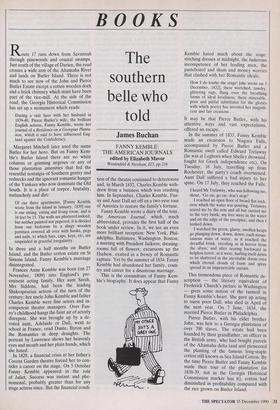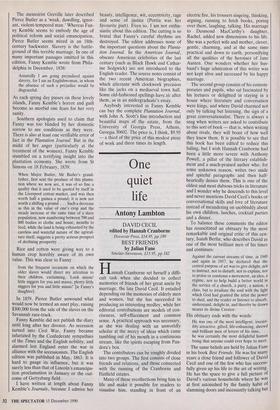BOOKS
The southern belle who told
James Buchan
FANNY KEMBLE: THE AMERICAN JOURNALS edited by Elizabeth Mayor
Weidenfeld & Nicolson, 115, pp.216
Route 17 runs down from Savannah through pinewoods and coastal swamps. Just south of the village of Darien, the road crosses a wide arm of the Altamaha River and lands on Butler Island. There is not much to see now of the John and Pierce Butler Estate except a rotten wooden dock and a brick chimney which must have been part of the rice-mill. At the side of the road, the Georgia 'Historical Commission has set up a monument which reads: During a visit here with her husband in 1839-40, Pierce Butler's wife, the brilliant English actress, Fanny Kemble, wrote her journal of a Residence on a Georgian Planta tion, which is said to have influenced Eng- land against the Confederacy.
Margaret Mitchell later used the name Butler for her hero. But on Fanny Kern- ble's Butler Island there are no white columns or grinning negroes or any of those plantation amenities that fed the resentful nostalgia of Southern gentry and rednecks and'the ignorant romantic hunger of the Yankees who now dominate the Old South. It is a place of torpor, brutality, melancholy and dirt:
Of our three apartments, [Fanny Kemble wrote from the island in January, 1839] one is our sitting, eating and living room, and is 16 feet by 15. The walls are plastered indeed, but neither painted nor papered; it is divided from our bedroom by a dingy wooden partition covered all over with hooks, pegs and nails, to which hats, caps, keys, etc, are suspended in graceful irregularity.
In three and a half months on Butler Island, and the Butler cotton estate on St Simons Island, Fanny Kemble's marriage disintegrated. Frances Anne Kemble was born (on 27 November, 1809) into England's pre- eminent acting family. Her aunt Sarah, Mrs Siddons, had been the leading Shakespearian actress of the turn of the century; her uncle John Kemble and father Charles Kemble were fine actors and in- competent theatre managers. Over Fan- ny's childhood hangs the faint air of actorly disrepute. She was brought up by a de- voted aunt, Adelaide or Da11, went to school in France, read Dante, Byron and the Romantics in deep draughts. The portrait by Lawrence shows her heavenly eyes and mouth and her plain hands, which she hated.
In 1829, a financial crisis at her father's Covent Garden theatre forced her to con- sider a career on the stage. On 5 October Fanny Kemble appeared in the role of Juliet. Success was instant and phe- nomenal, probably greater than for any stage actress since. But the financial condi- tion of the theatre continued to deteriorate and, in March 1832, Charles Kemble with- drew from a business which was crushing him. In September, Charles Kemble, Fan- ny and Aunt Dalt set off on a two-year tour of America to restore the family's fortune.
Fanny Kemble wrote a diary of the tour, the American Journal, which, much abbreviated, provides the first half of the book under review. In it, we see an even more brilliant reception: New York, Phil- adelphia, Baltimore, Washington, Boston; a meeting with President Jackson; dressing- rooms full of flowers; excursions up the Hudson, exalted in a frenzy of Romantic rapture. Yet by the summer of 1834, Fanny Kemble had abandoned her family, coun- try and career for a disastrous marriage.
This is the conundrum of Fanny Kern- ble's biography. It does appear that Fanny Kemble hated much about the stage: stitching dresses at midnight, the ludicrous incompetence of her leading men, the pasteboard and sham and money worries that clashed with her Romantic ideals:
How I do loathe the stage! [she wrote on 5 December, 1832], these wretched, tawdry, glittering rags, flung over the breathing forms of ideal loveliness; these miserable, poor and pitiful substitutes for the glories with which poetry has invested her magnifi- cent and fair creations . . .
It may be that Pierce Butler, with his attentive ways and vast expectations, offered an escape.
In the summer of 1833, Fanny Kemble made an excursion to Niagara Falls, accompanied by Pierce Butler and a Romantic swell called Edward Trelawny (he was at Leghorn when Shelley drowned, fought for Greek independence etc). On Tuesday, 16 July, travelling up from Rochester, the party's coach overturned. Aunt Da11 suffered a bad injury to her spine. On 17 July, they reached the Falls: I heard Mr Trelawny, who was following me, shout, Go on, go on: don't stop!'
I reached an open floor of broad flat rock, over which the water was pouring. Trelawny seized me by the arm and all but carried me to the very brink; my feet were in the water and on the edge of the precipice, and then looked down.
I watched the green, glassy, swollen heaps go plunging down, down, down; each moun- tainous mass of water, as it reached the dreadful brink, recoiling as in horror from the abyss; and after rearing backward in helpless terror, as it were, hurling itself down to be shattered in the inevitable doom over which eternal clouds of foam and spray spread in an impenetrable curtain.
This tremendous piece of Romantic de- scription — the literary equivalent of Frederick Church's picture in Washington — gives some notion of the turmoil in Fanny Kemble's heart. She gave up acting to nurse poor Da11, who died in April of the next year. On 7 June, 1834, she married Pierce Butler in Philadelphia. Pierce Butler, with his elder brother John, was heir to a Georgia plantation of over 700 slaves. The estate had been founded by their grandfather, an officer in the British army, who had bought parcels of the Altamaha delta land and pioneered the planting of the famous long-staple cotton still known as Sea Island Cotton. By the time Pierce Butler and Fanny Kemble made their tour of the plantation (in 1838-39, not as the Georgia Historical Commission marker has it), cotton had diminished in profitability compared with the rice grown on Butler Island. The memoirist Greville later described Pierce Butler as a 'weak, dawdling, ignor- ant, violent-tempered man.' Whereas Fan- ny Kemble seems to embody the age of political reform and social emancipation, Pierce Butler seems mired in an 18th- century backwater. Slavery is the battle- ground of this terrible marriage. In one of many important passages omitted in this edition, Fanny Kemble wrote from Phila- delphia in December, 1838:
Assuredly I am going prejudiced against slavery, for! am an Englishwoman, in whom the absence of such a prejudice would be disgraceful.
As each spring day passes on these lovely islands, Fanny Kemble's horror and guilt become so morbid one fears for her very sanity.
Southern apologists used to claim that Fanny was too blinded by her domestic sorrow to see conditions as they were. There is also at least one verifiable error of fact in the Plantation Journal. But in the midst of her anger (particularly at the treatment of the women), Fanny Kemble stumbled on a terrifying insight into the plantation economy. She wrote from St Simons on 18 February, 1839:
When Major Butler, Mr Butler's grand- father, first sent the produce of this planta- tion where we now are, it was of so fine a quality that it used to be quoted by itself in the Liverpool cotton market, and was then worth half a guinea a pound; it is now not worth a shilling a pound . . . Such a decrease as this in the value of one's crop and the steady increase at the same time of a slave population, now numbering between 700 and 800 bodies to clothe and house, mouths to feed, while the land is being exhausted by the careless and wasteful nature of the agricul- ture itself, suggests a pretty serious prospect of declining prosperity . . .
Rice and cotton were giving way to a human crop horribly aware of its own value. This was clear to Fanny
from the frequent occasions on which the older slaves would direct my attention to their children, exclaiming, 'Look missis! little niggers for you and massa; plenty little niggers for you and little missis!' Lie Fanny's daughter].
In 1859, Pierce Butler unwound what would now be termed an asset play, raising $300,000 from the sale of the slaves on the Savannah race-track.
Fanny Kemble did not publish the diary until long after her divorce. As secession turned into Civil War, Fanny became infuriated by the Confederate sympathies of the Times and the English nobility, and alarmed lest England enter the war in alliance with the secessionists. The English edition was published in May, 1863. It is hard to guage its influence, but it was surely less than that of Lincoln's emancipa- tion proclamation in January or the out- come of Gettysburg field.
I have written at length about Fanny Kemble's Journals, because I admire her beauty, intelligence, wit, eccentricity, rage and sense of justice (Portia was her favourite part). Even so, I am not enthu- siastic about this edition. The cutting is so brutal that Fanny's careful rhythms are destroyed. The editor addresses none of the important questions about the Planta- tion Journal. In the American Journal, obscure American celebrities of the last century (such as Black Hawk and Cathar- ine Sedgwick) are not introduced to the English reader. The source notes consist of the two recent American biographies, which alternate with clockwork precision like the jacks on a mediaeval town hall. Some old-fashioned spellings have sic after them, as in an undergraduate's essay.
Anybody interested in Fanny Kemble can buy the complete Plantation Journal, with John A. Scott's fine introduction and beautiful maps of the estate, from the University of Georgia Press, Athens, Georgia 30602. The price is, I think, $9.95 — a third of the price of this modest piece of work and three times its length.



























































 Previous page
Previous page